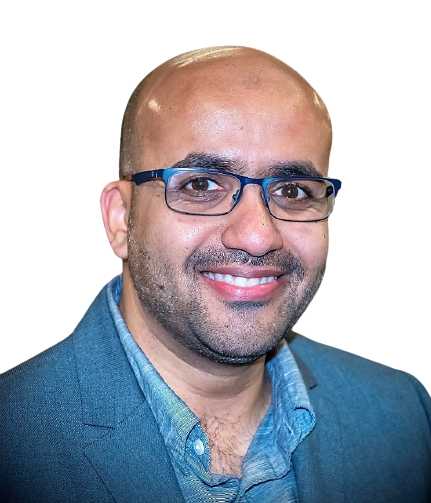Tutorials
Title:
AI-Driven Optimization & Model Calibration When Failure Data Is Scarce
Speaker:
Peeyush Pankaj, MathWorks
Abstract:
To build accurate, data-driven diagnostic and prognostic models, when we have lack of failure data, it's essential to first generate failure mode data through physics-based simulations that closely align with real-world test data. But correlating high-fidelity simulations to physical test results can be time-consuming. In this session, we'll show how AI-powered Reduced Order Models (ROMs)—combined with optimization—can dramatically speed up the model correlation process while also enabling design space exploration.
Through a Turboshaft Engine case study, we'll walk through a complete workflow: correlating simulations with test data for failure mode synthesis, building surrogate models, and mapping the full landscape of feasible design solutions in a multi-objective context. This approach is scalable and agnostic to domain, applicable to any complex system requiring intelligent design and diagnostics.
Session Highlights:
- AI for Design Optimization
- Generate and explore a high-dimensional design space.
- Reduced order models to simulate complex system behavior.
- Use AutoML to create fast surrogate models.
- Run multi-objective optimization and visualize trade-offs across objectives.
- Design Space Thinking > Design optimization.
- Model Calibration Workflow
- Quickly estimate simulation parameters using optimization and AI-ROMs.
- Align simulation outputs with physical test data to enable failure mode generation.
This session is a must for engineers building robust diagnostic systems and next-gen designs powered by simulation intelligence and AI.
Speaker bio:

Peeyush Pankaj is a Principal Application Engineer at MathWorks, where he collaborates with engineering teams across the Automotive, Aerospace, and Industrial Automation (IAM) sectors to develop and deploy AI-powered solutions for complex system challenges. Prior to MathWorks, he was at GE Aviation, working on the design, testing, and certification of aircraft engines and holds 25 patents in jet propulsion technologies and prognostic health monitoring. Peeyush holds a Master’s degree in Advanced Mechanical Engineering from the University of Sussex, UK.
Title:
Open Access Tools, Ontologies, and Data Sets for Extraction and Semantic Exchange of Maintenance Information
Speaker:
Professor Melinda Hodkiewicz, The University of Western Australia
Abstract:
The UWA NLP-TLP group has had over $1.8M of funding since 2018 to develop tools and processes to “Transform Maintenance through Data Science”. By collaborating with over 20 national and international organisations we have developed and released 11 open-source language processing software and web tools and the largest maintenance dataset for fine-tuning AI models.
This talk describes these tools, what value they add for reliability engineers and planners, and how organisations are using them. Open access AI language tools establish enable semantic exchange of maintenance data within and between organisations. Continuing to process maintenance texts and procedures manually is no longer acceptable from productivity or quality control perspectives now we have viable and open AI-enabled alternatives.
This talk covers issues of interest for business managers, computer scientists, data analysts, engineers, and academics who engage in maintenance, reliability and design. Moving from the strategic of business imperatives and global standards to the details such as the challenges of managing ontologies, the aim is to extend participants understanding of this fast moving landscape.
Links: Links to GitHub repos and other web-based resources for all the tools discussed will be provided in the slides.
Speaker bio:

Professor Melinda Hodkiewicz is a maintenance engineer who for the last decade has been leading technical developments and industrial applications in the field of Technical Language Processing (TLP). TLP covers the pragmatic adaption of natural language processing, knowledge graphs, and ontology for semantic exchange of written data and knowledge in technical texts. Her focus is on the development of open, shared standards, code and data sets for industry.
Melinda's past roles have included Chair Standards Australia MB19 committee ISO 55000-2 Asset Management (2012-2015), NOPSEMA Advisory Board (2017-2022), $2M BHP Fellow for Engineering for Remote Operations (2016-2022), and visiting Fellow at the Alan Turing Institute in the UK. In 2016 she was awarded the MESA Medal – The Lifetime Achievement Award for services to the asset management community in Australia. She co-leads to NLP-TLP group at the University of Western Australia and from 2020-2022 was part of the leadership team for the $8.8M Australian Government and industry co-funded Training Centre (ITTC) for Transforming Maintenance through Data Science. Since 2021 she has represented Standards Australia on the International Standards Organisation ISO TC184 SC4 committee for Industrial Data and is ab active developer of standards in the ISO DIS 23726 family on Ontology-based interoperability. She also leads the Maintenance Working Group for the Industrial Ontology Foundry program. Through her Standards work she has close links with many international associations and organisations. In 2019 she was made a Fellow of the Australian Academy of Technology and Engineering (ATSE).
Title:
Generative AI Meets PHM: From Building Worker Assistants to Training Domain-Specific Models
Speaker:
Dr. Ahmed Farahat, Hitachi America
Dr. Aman Kumar, Hitachi America
Abstract:
Prognostics and Health Management (PHM) solutions can benefit significantly from AI that is both domain-aware and efficient, particularly in constrained industrial environments. While generative AI models are powerful, they often face challenges in accuracy, interpretability, and deployability when applied to specialized PHM tasks such as diagnostics, inspection and prognostics of equipment conditions. In this tutorial, we aim to show how these challenges can be overcome to build practical, real-world PHM solutions that successfully leverage generative AI.
This tutorial is divided into two complementary parts. In the first part, we will provide an overview of recent advances at the intersection of generative AI and industrial AI for prognostics and health management, covering emerging approaches, technical and organizational challenges, and representative use cases. Examples include using generative AI and visual language models to assist industrial workers with troubleshooting, diagnostics, and repair, as well as building robotic systems for asset inspection using agentic AI and novel reasoning frameworks. We will highlight both the challenges and opportunities in deploying generative AI in high value, safety and mission critical environments.
In the second part, we will focus on methods for building domain-specific models tailored for PHM. We will walk the participants through a step-by-step approach for constructing domain-specific Small Language Models (SLMs) and Visual Language Models (VLMs). Participants will learn how guided-generation of synthetic data, domain-adaptive pretraining, supervised fine-tuning, and preference alignment can produce compact domain-specific language models that achieve strong diagnostic performance while remaining cost-efficient and deployable at the edge. We will also show how VLMs can combine image and text modalities to deliver better performance on diagnostic task using component imagery, and manuals.
The tutorial is designed for researchers and practitioners in PHM, industrial AI, and applied machine learning who are interested in understanding recent developments in generative AI and gaining practical knowledge for developing domain-specific language models suitable for safety critical environments.
Speaker bio:

Dr. Ahmed Farahat is a Director, Applied AI R&D, at the Industrial AI Laboratory at Hitachi America, Ltd. R&D. He holds a Ph.D. degree from the University of Waterloo in Canada, as well as M.Sc. and B.Sc. degrees from Cairo University in Egypt, all in Computer Engineering. Ahmed is deeply passionate about applying AI and advanced technologies to solve complex challenges in industry, aiming to foster significant societal advancements. He has co-invented over 30 patents and contributed to more than 40 scholarly papers.

Dr. Aman Kumar is a Research Scientist at the Industrial AI Lab at Hitachi America Ltd. He holds a Ph.D. in Industrial Engineering and Computer Science from North Carolina State University. Currently, he focuses on the development, evaluation, and application of domain-specific language and vision foundation models for industrial use cases. His work spans both unsupervised and supervised training of models tailored to manufacturing, diagnostics, and maintenance settings. He has published in leading venues across advanced manufacturing, natural language processing, and machine learning.
Title:
Applying Causation Based AI for Explainable Prognostics & Health Management )
Speakers:
Navid Zaman, PHM Technology
You-Jung Jun, PHM Technology
Abstract:
Machine learning and deep learning models have become common in PHM, yet confidence in their predictions remains limited because they demand large historical data sets, are prone to spurious correlations, and rarely expose the engineering logic behind their outputs.
Causation Based AI (Cb AI) addresses these gaps by explicitly modelling the causal relationships that link symptoms to root causes. When anchored to a system’s Digital Risk Twin, CB AI embeds engineering context, produces transparent reasoning paths, and achieves high integrity diagnostics with only modest data. It also enables earlier detection of incipient and cascading faults, traceable fault propagation paths, and rapid adaptation to design changes.
This tutorial will give participants a clear, practical roadmap for moving from black box correlation to causation driven insight. We will cover the fundamentals of CB AI, walk through a step by step workflow for building causal diagnostic models, and benchmark the approach against conventional data driven FDI. A live case study drawn from mission critical industry will illustrate how CB AI, paired with a Digital Risk Twin, delivers explainable, regulatory alignment PHM analytics that scale from design to field deployment.
Session Highlights:
- Limits of correlation based FDI – extensive historical data, overfitting, and lack of engineering context.
- Model-Based FMEA and Dependencies – extracting failure syndromes and dependency maps from FMEA/design data to form the CB AI knowledge base.
- Digital Risk Twin synergy – using dynamic system models to keep diagnostics accurate as configurations evolve.
- Example case study – failing component flow in a mission critical system with sparse sensor data.
Speaker bio:
Navid Zaman is the Lead Data Scientist at PHM Technology, mainly working on causation-based AI and failure detection and isolation tool Syndrome Diagnostics. His main responsibilities are around R&D involving data-driven and AI technologies.
You-Jung Jun is a data scientist at PHM Technology, Melbourne, where he works with multidisciplinary engineers to develop AI-powered solutions for fault detection and isolation. His research interests include data science, machine learning, and large language models, aiming to advance prognostics and health management. He holds a master's degree in artificial intelligence from the University of Melbourne and a bachelor’s degree in industrial engineering from Soongsil University, South Korea.
Title:
Compressing Deep Neural Networks for Prognostics and Health Management (PHM)
Speakers:
Qing Xu, Institute for Infocomm Research
Xue Geng, Institute for Infocomm Research
Abstract:
Deep learning has emerged as a powerful tool in Prognostics and Health Management (PHM), enabling capabilities such as fault detection, anomaly classification, and Remaining Useful Life (RUL) prediction. However, state-of-the-art neural networks often require substantial computational resources and memory, which poses challenges for deployment in real-time and edge applications prevalent in industrial settings.
This tutorial aims to equip participants with a foundational understanding of deep neural network compression techniques, focusing on their relevance and application in PHM. We will explore the motivations behind model compression and delve into three core methodologies:
- Network Pruning – removing redundant parameters to streamline model architecture;
- Quantization – reducing numerical precision to optimize for memory and speed;
- Knowledge Distillation – transferring knowledge from a large model (teacher) to a smaller one (student).
The tutorial is structured around three main components:
- Basic Concepts: Introduction to neural network over-parameterization and challenges in PHM deployment.
- Emerging Compression Solutions: Overview of recent advances in compression solutions.
- Use Cases: Practical examples from aerospace and manufacturing, showing how compression enables edge-based diagnostics and predictive maintenance.
This session will be valuable for both researchers and practitioners seeking to deploy deep models in constrained environments, and for those interested in the future of efficient AI in PHM.
Speaker bio:
Qing Xu is a Senior Research Engineer with the Institute for Infocomm Research, Agency for Science, Technology and Research (A*STAR), Singapore. His research interests include deep learning, transfer learning, model compression, and related applications. He received the B.Eng. degree in measuring control technology and instruments and the M.Eng. degree in instrument science and technology from Southeast University, Nanjing, China, in 2010 and 2015, respectively. He is currently a PhD candidate (Thesis submitted) at Nanyang Technological University (NTU), Singapore.
Xue Geng received her B.E. degree in Computer Science from Northeastern University, China, in 2012, and her Ph.D. in Computer Science from the National University of Singapore in 2017. She is currently a Senior Scientist at the Institute for Infocomm Research (I²R), A*STAR, Singapore. Her research focuses on model compression and efficient machine learning. She has a proven track record with over 10 high-quality publications in top-tier venues, including CVPR, NeurIPS, ICCV, ECCV, ACL, ACM Multimedia, TNNLS, and T-PAMI.